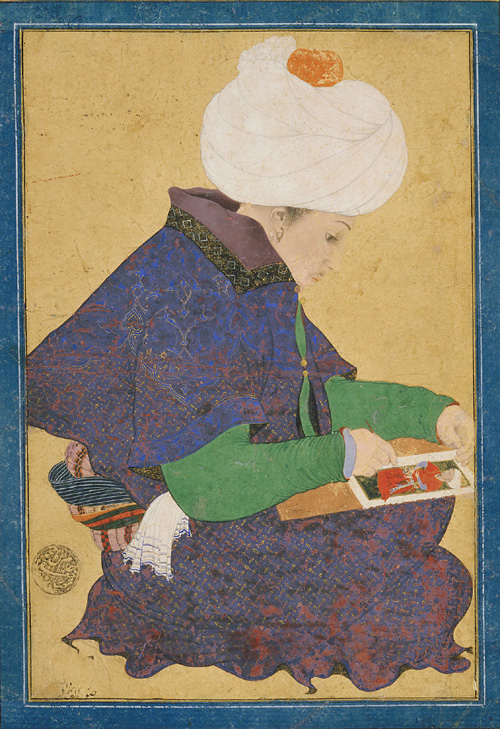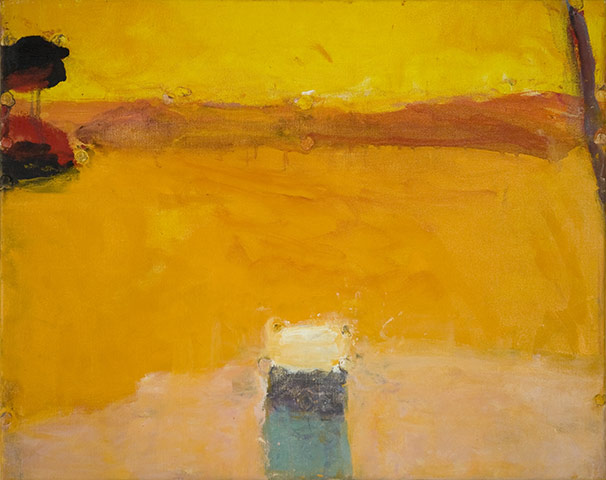 |
| A painter from the court of Mehmet II. |
| Picture from Wikipedia. |
There are many ways in which My Name Is Red is a beautiful book. I will not try to discuss most of them, because this isn't the place and I don't have the words. But it was Orhan Pamuk's discussion of painting and blindness that pierced and wove itself into the cloth of allusions in my mind. Embarrassingly, several months ago I already started and didn't finish a blog post on blind painters.
For the Ottoman and Persian miniaturists who hunched close to their work in dim candlelight, vision loss and eventual blindness was a universal fear. The painters of the Herat school learned to overcome this fear, according to Pamuk, through their philosophy of painting, believing that "the illuminator draws not what he sees, but what Allah sees" and that blindness is a gift from Allah which allows the artist to see these perfect archetypes unsullied by the imperfect objects of the real world.
As such, a blind miniaturist was in a similar position to a deaf Beethoven: their art consisted of arranging stereotyped elements on a page in a novel and pleasing way, of composition, in one sense and the other. Indeed, just as the composer doesn't always play or conduct his own music, so the miniaturist might leave the rendering of certain details to apprentices. But since the archetypes that he draws are preserved in muscle memory, he can often also do it himself.
Driving this analogy onto more tenuous ground, Western artists are more like rock stars, whose sounds are their property: if anyone else performs them, they can at best be a cover. Though I imagine rock stars go deaf with some frequency (a quick Google search seems to confirm this) I doubt many of them would consider playing music without hearing it. (If they do, this would be a great topic for a blog post by someone who isn't me.) This post is about today's blind painters, who paint by themselves and as themselves; about how and why.
ا ʾAlif
 |
| Sargy Mann, Point Steps II |
Despite having been blind for 16 years when the footage was taken, Mann still understands the world in a profoundly visual way. Moreover, even when completely blind he reports a visual experience linked to painting:
[A]lthough I am totally blind now, I just see the canvas changing color when I put a pigment down on it … it's not like somebody else seeing the color. Well, it's like I have seen the color when I have been painting with the amount of sight I have had before about a week ago.Perhaps as a tradeoff, he can't interact with his surroundings through touch and hearing in the effortless way I expect of blind people. For example, he's not aware of a person coming up the steps that he's investigating. It's as if his brain hasn't reconfigured itself radically, hasn't given the mostly useless visual cortex over to the other senses.
 |
| Sargy Mann, Yellow Seascape, 2010. |
You've got to sort of stop people making a quick wrong guess, or do your best to stop them. I mean, paradoxically, I think what happens, simply, if you do that is they say "Oh, I see, it's an abstract, yeah, lovely!"with the later:
…you silly bugger, you won’t be able to see it. You can make the chair any colour you like.He can, of course, but not if his aim is to make reality pop out at you.)
This last quote I lifted from a neuroscientist, Semir Zeki, the self-appointed pioneer of 'neuroaesthetics,' who is greatly excited by this transformation. Zeki, says the Guardian, has been angling to put Mann in an fMRI machine, to see if it's his V4 that's responsible for his flashes of color, but Mann is resisting. Whether or not that is the case, Sargy Mann's art is still informed by the long period when he was a sighted artist, and he has continued to paint in much the same way. Perhaps even he is less of a blind painter -- less at home in his blindness -- than the miniaturists whose skill was in muscle memory, in the hands rather than in the eyes. So the question of whether or not blindness has improved his painting is a bit academic: even if you have an opinion, it's hard to separate the effect of blindness from that of age and experience.
ب Bāʾ
 |
| John Bramblitt, Iago |
John Bramblitt learned to paint in color by internalizing the textures of oil paints. But eventually, as we see in his documentary, the textures become important as qualia in their own right:
Sometimes I'll decide on a color just 'cause I like the way it feels.Finally, names of colors are disassociated from visual stimuli and have come to represent texture:
Y'know, if I touch a person's skin, it may feel like red, and I know the person isn't colored red, but in my mind they are. And I've stopped thinking to myself that that's wrong.So too does the blind master in Orhan Pamuk's chapter on red remark that "colors are not known, but felt."
Lisa Fittipaldi quit painting after ten years and switched to publishing books with titles like Knitting Across America with a Big Poodle. But John Bramblitt is still exploring. Displaying a synaesthesia which binds color not only to texture but also to sound and taste, he has created a series of paintings inspired by wines and pieces of music. We return to the fictional blind master's description of red:
If we touched it with the tip of a finger, it would feel like something between iron and copper. If we took it into our palm, it would burn. If we tasted it, it would be full-bodied, like salted meat. If we took it between our lips, it would fill our mouths. If we smelled it, it'd have the scent of a horse. If it were a flower, it would smell like a daisy, not a red rose.
ج Jīm
1.
Apparently it was Karl Marx who said that history repeats itself twice: the first time as tragedy, the second as farce. My Name Is Red describes the tragedy that happened when the Western arts of perspective and portraiture reached Istanbul. Under different circumstances this could have led to the blossoming of a new hybrid art combining Western and Ottoman sensibilities, depicting the immutable truth of Allah and its delicate symbols with a new power; and to some degree this happened. But this art inevitably suffered from an inferiority complex fueled by accusations of imitation and blasphemy because even miniature had always been religiously suspect and the new infidel art seemed to compete with religion in the power and directness with which it could access emotions in a way that even hybridized miniature could not.
400 years later, perspective reaches a solitary Turkish painter, Eşref Armağan, who is blind from birth. It comes in the form of a film crew from the Discovery Channel and a free plane ticket to Florence, where easily-bought Canadian and Harvard neuroscientists place him irrelevantly in front of the octagonal baptistery and give him a cardboard model he can draw. Bravo, they cry. The blind man can draw pictures of what sighted people see. Too bad he can't see it for himself.
2.
Of course, who but Allah can see five sides of an octagonal prism at once?
3.
 |
| A still life by Eşref Armağan. |
On the other hand, what qualia does Armağan have that I do not? What in his paintings can I not see just by looking at them? In the video, he voices a desire to be known as an artist, not as a freak show act. But I don't know if this is possible if he keeps trying to cater to the sighted. A human with a fishing rod can hardly compete with sharks for mastery of the ocean, but does pretty well on land. And while he hasn't found a blind community that will appreciate his work for what it is, I'm afraid that Armağan will only get recognition from Volvo commercials.
"What are the morals of the three videos you've shown?" asks Black.
"ʾAlif," I say. "The story of Sargy Mann demonstrates that a painter who has been blinded can rely on his memory and experience to continue perfecting his art. Bāʾ: the second story reveals that painting can also be liberated from vision and into the domain of the other senses."
"Jīm!" says Black confidently... well, you can fill this in.


No comments:
Post a Comment